Men’s Watches: The Difference Between Quartz & Mechanical Movements
August 13, 2019DMT.NEWS#DMTBeautySpot #beauty
Men's watches – their utility to a man's style is immeasurable.
They carry a treasured history that dates as far back as the 1540s with the birth of the Swiss watch industry.
Nevertheless, we're discussing something more specific today – our contribution to a fiery debate between watch enthusiasts: the differences between quartz and mechanical movements, and whether one is superior.

Which one is best for you? Read on, my friend.
Today’s article is brought to you by Vincero, makers of stylish men’s watches that look and feel as good as other watches 10x the price. If you haven’t been to their website in a while, you need to check out their new designs, especially the Kairos Automatic.
Your watch tells the world and others around you what you are about. Vincero makes bold designs for guys looking to set themselves apart at an affordable price. With a distinct look and quality feel, these watches get noticed and complimented. Click here to check out Vincero's 5 Year Anniversary Sale!
Click Here To Watch The Video – Quartz vs Mechanical & Automatic Watches (Which Watch Type To Buy?)
Overview – An intro To Quartz & Mechanical Movements
Before we can get into specifics about men's watches, we first need to garner an understanding of how both of them work. Only then can an aspiring watch collector truly appreciate them both.
Mechanical Movements
Mechanical movements fall into one of two subcategories: manual and automatic watches. In a manual watch, the wearer has to turn the crown (the winder) on the top of the watch to tighten the mainspring.
The watch should then work for roughly 40 hours prior to the next winding. Some even have a power reserve that extends it to 10 days.
Automatic variants are powered instead by an oscillator which automatically winds the mainspring to power the watch. The oscillator can be thought of as a type of rotor which spins when the wearer moves his wrist. This means that the watch is powered entirely by kinetic energy.
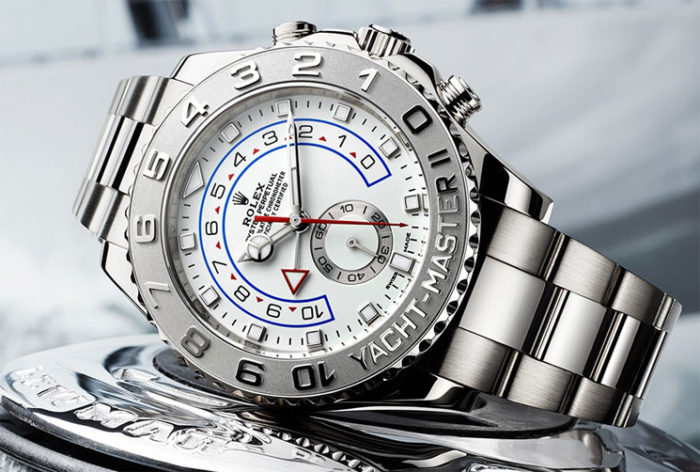
The Rolex Yacht Master II is an example of a mechanical watch.
Both types have a similar construction, however. Winding puts pressure on the mainspring, which creates a force that is then transferred through the gear train (the collective term for the components in the watch) to an escapement. This puts out a little bit of power each time.
This power is released in intervals consistent with that of a 24-hour day. Though the concept remains timeless, advanced technology and manufacturing methods have made mechanical movements more accurate than ever.
Quartz Movements
First introduced in 1969 by Japanese manufacturer Seiko, quartz movements are much simpler by comparison. They were made with the goal to challenge traditional perspectives on watch production.
Up until this point, there had only ever been mechanical watches, which were difficult for the layman to afford. Cheaper quartz movements changed the watch industry forever.
Quartz movements are powered by a battery. They require no winding whatsoever.
The batteries in the case send electric signals to a quartz crystal, causing it to vibrate 32,768 times per second. These vibrations are then measured through a circuit and converted into singular electrical pulses – one pulse per second.
The result is a watch which is far more accurate than any mechanical watch thus far.
1. The Cost
Now, let's get down to brass tacks and talk differences. We'll start with cost.
Quartz Movements
Generally speaking, quartz movements will be far cheaper than their mechanical counterparts. There will be some overlap, but mechanical movements can fetch a significantly greater price tag than quartz could ever aspire to.
You could easily find a quartz watch at a range between $5 and $100. This has to do mostly with the mechanism itself. Since quartz movements work electrically through a battery, they are simpler to manufacture.
Don't assume they're all cheap, though. Higher-end quartz movements exist. The Grand Seiko 9F has a price tag of $2,300, while the Breitling Exospace B55 will run over $8,000. These factors are mainly due to the materials used in the case, crystal, and the number of complications on the watch.
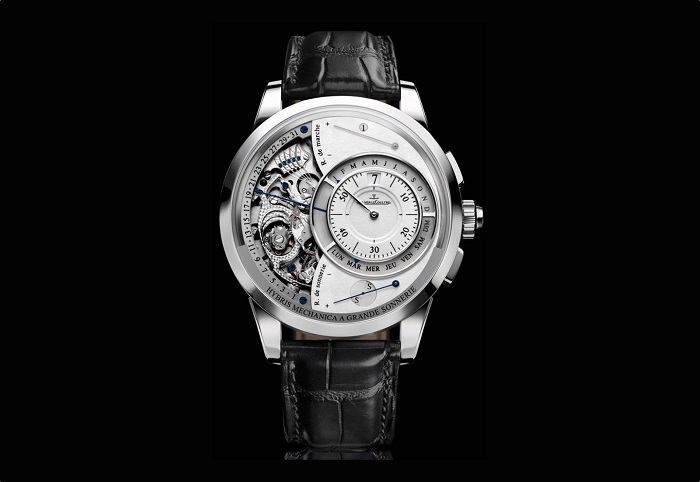
The Jaeger Lecoultre Hybris Mechanica is an extreme example of an expensive mechanical watch.
Mechanical Movements
These gems can run generally between $50 to $1,000. You can reliably find a quality automatic for $500 or so. However, the price tag of some automatic movements can soar to incredible heights. The Jaeger Lecoultre Hybris Mechanica is one such example that runs for $2.5 million.
Though there are several factors at play, just as in quartz movements, pricing in mechanical watches is influenced considerably more by the mechanism itself – being far more complex than its opponent.
2. Craftsmanship
We talked about cost and touched on the relative complexity of each movement, but let's dive into more detail.
Quartz Movements
These watches consist of a total of 14 parts:
- The stem
- The circuit
- Coil
- Battery insulator
- Contact
- Battery strap
- Quartz crystal
- Detent
- Battery
- Plate
- Train bridge
- Dial foot clamp
- Case screw
- Coil cover
The key players in this list are the quartz crystal and the circuit through which the watch is powered. All-in-all, it's a simple amalgamation that relies on technology more so than craftsmanship. It takes less skill and detail to put together, which means there is less attention to the craftsmanship involved.
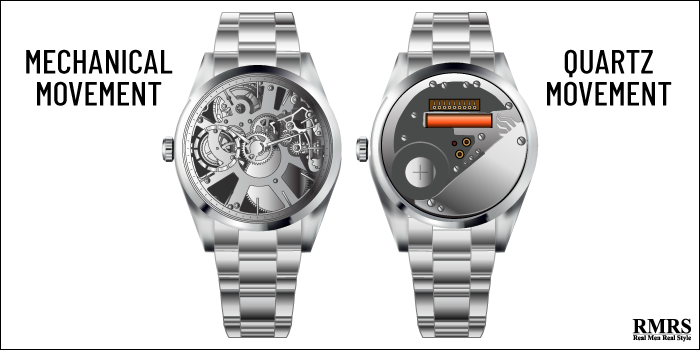
The mechanism in a mechanical movement is more complex – and more expensive – than in quartz movements.
Mechanical Movements
The craftsmanship behind mechanical movements is the main reason they are sought after by collectors.
As stated above, the simplest mechanical watches have approximately 130 components, far outshining the quartz movement in complexity from the outset. Others can have thousands of moving parts.
A mechanical watch also has gravity to compete with. Gravity interferes with the most delicate aspects of a watch's functionality. To mitigate this, Abraham-Louis Bréguet invented the Tourbillon around 1795. This mechanism features a balance wheel and escapement in a rotating cage, which is used to better-ensure accurate time keeping.
The first owner of a clock with such a device was emperor Napoleon himself.
Over the years, Tourbillons have gotten more and more efficient as well as complex. A notable example is the Thomas Prescher Triple-Axis Tourbillon Regular Sport – created in 2004.
3. Durability
Discussing the durability of these movements is a bit simpler in scope.
The strength of quartz movements lies with their impact resistance. The simplistic mechanism means that it's less likely to break. If you couple this design with something like a dive watch, you can have a watch that's almost invincible.
Quartz watches may take more of a beating, but mechanical watches could last forever.
Though mechanical watches are more likely to break from a fall, they have the advantage of longevity. Without a battery, mechanical movements are functionally immortal. Though this depends heavily on care and craftsmanship, a quality mechanical watch can easily outlast you and your children!
4. Maintenance
Let's break down how much attention these beauties will need.
Quartz Movements
The advantage of a quartz movement is that it requires very little care over a long time. The only maintenance usually occurs every 2-5 years when the watch battery needs to be replaced. Things can get slightly more complicated with water-resistant watches though, as the mechanism will need to be resealed and pressure-tested.
These services will run you about $45-$60.
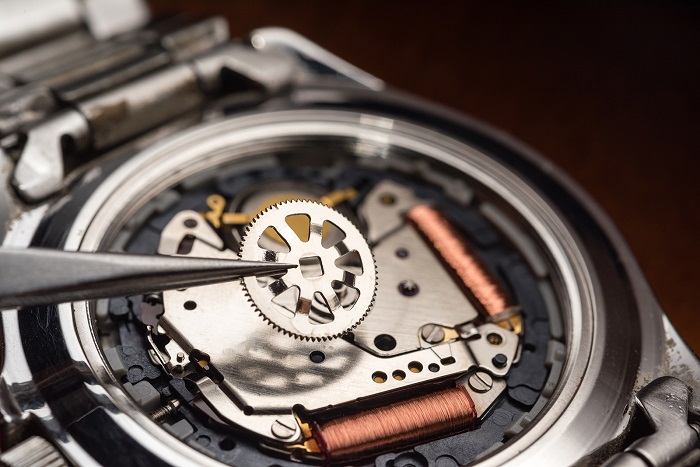
Quartz watches are simpler to repair. Mechanical movements will require more careful attention.
Mechanical Movements
As you would expect, mechanical watches are a little more complicated to take care of. It's recommended that you take it in for maintenance precisely every 3 years.
The reason is in the oils that ease the movement of the gear train. They gradually break down regardless of how you handle the watch. If you wait longer than 3 years to service it, you are slowly killing it off.
Service isn't cheap either. Depending on the caliber of your watch, you might be looking at prices ranging between $85 to $450.
Mechanical movements are a commitment, make no mistake!
5. Hand Movement
This is actually the most reliable factor in telling apart a quartz movement from a mechanical movement.
Quartz Movements
Since the mechanism in a quartz watch experiences a pulse every second, the watch hand moves in individual ticks – exactly once per second.
This is due to power efficiency. An individual tick consumes far less power than if it were to imitate a mechanical watch.
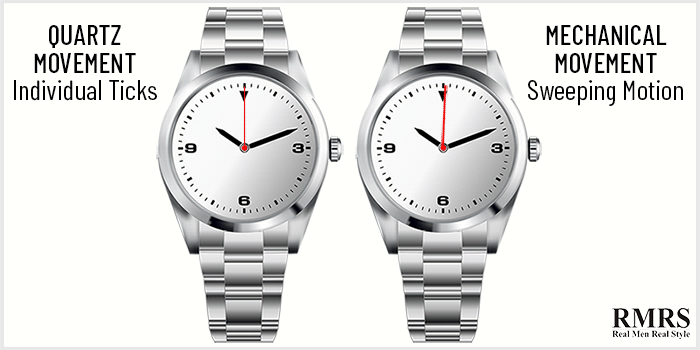
Note the difference in the motion between the quartz and mechanical movements.
Mechanical Movements
The gear train moves the second hand every time the balance swings. This happens 6-8 times for second. To the eye, this makes for a continual gliding motion of the hand on the watch.
Don't be fooled – it's not a smooth motion, it just ticks faster in smaller increments. Some mechanical men's watches tick audibly, but most don't.
6. Power Source
How do quartz and mechanical movements derive their strength?
Quartz Movements
The main battery tends to rest in a “nest.” The negative contact strap lies along the bottom of the nest, whereas the positive strap rests against the side. In certain models, the strap that holds the battery down doubles as the positive contact.
However, the straps need to be totally clear of any residue. While residue rarely builds up within the watch, it could be the culprit if the watch starts ticking improperly or irregularly. In such a case, it is recommended that you clean the straps with a piece of sharpened peg wood. If a problem persists, then consider using typewriter eraser.
Care needs to be taken when handling the mechanism. If the battery is held by a screw, loosen the screw as carefully as possible so the screwdriver doesn't damage the entire mechanism.
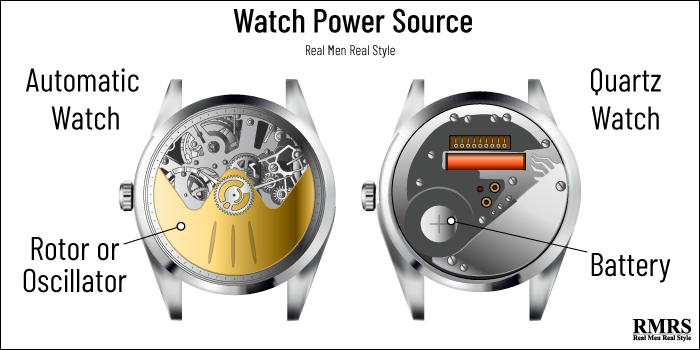
While a quartz movement relies on a battery, automatic watches use a rotor that powers the watch through kinetic energy.
Mechanical Movements
These watches are driven by a mainspring which is wound periodically – either by the oscillator in an automatic watch or by hand.
The force is distributed through the gear train to power the balance wheel. This wheel is what rotates back and forth to power the watch.
7. Accuracy
Is there a difference in how well quartz and mechanical movements tell time?
You bet.
Quartz Movements
Quartz watches take the cake as far as accuracy goes. Since they rely on very precise electric pulses, they are able to stay on point no matter what.
Over time, all watches will start to become a little off in terms of reporting the exact time, but with quartz watches, there's no more than a one-second change per day on average.
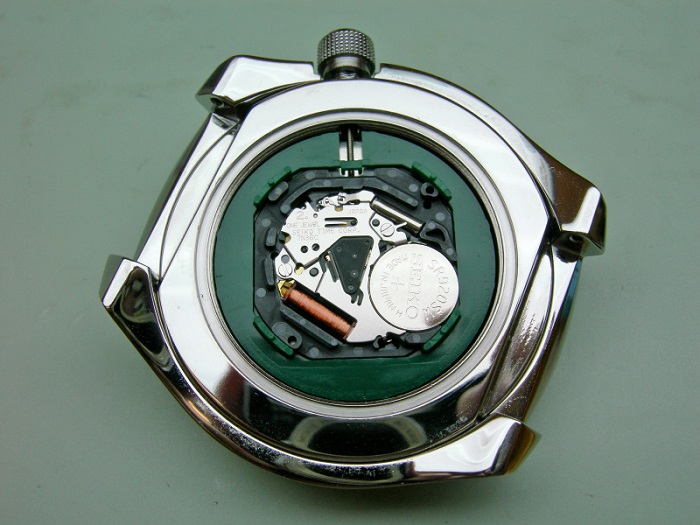
A quality quartz watch will vary only by a second a day.
Mechanical Movements
Accuracy is a more… complicated matter for mechanical watches.
These watches are unfortunately far more prone to variation due to a myriad of reasons:
- The position of the crown on the watch (up or below) can impact its accuracy.
- They can gain seconds due to strong wrist movements or shock.
- Temperature.
- How far along it's been wound. Failing to wind consistently will exacerbate the problem.
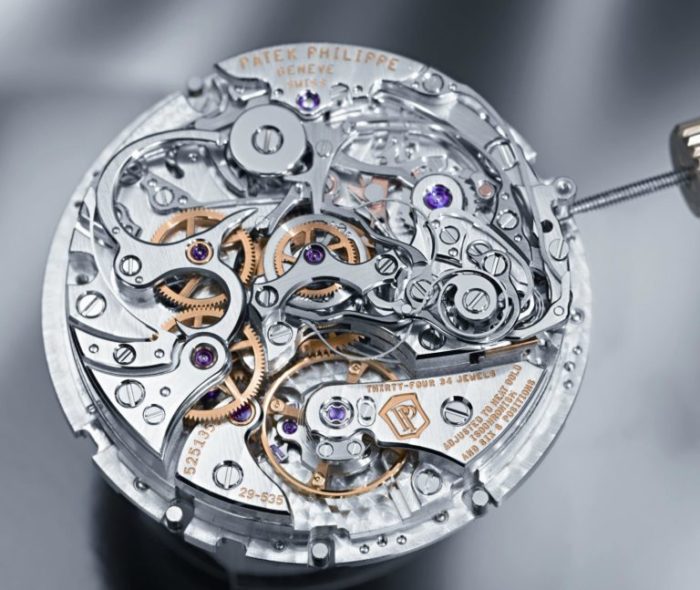
Mechanical movements are far less accurate than quartz.
Mid-range luxury watches such as Rolex and Omega are off by about 2 seconds a day. Fortunately, both companies are relentlessly pursuing higher standards which make them more accurate than the traditional Swiss COSC standard.
An entry-level luxury watch will typically vary by 4-6 seconds a day. $400-$800 watches by Swiss and Japanese brands won't be certified, which means you'll get significantly more variation. We're talking time that can be off by about 12 seconds a day.
Don't get me started on budget ($100-$200) watches. These are quite unpredictable and require the most attention. They can vary as far as 25 seconds a day.
If you consider a budget watch, please find a model that follows some form of regulation. Those are accurate to within 10 seconds a day.
8. Heritage
Are you looking for a treasured history to be proud of? Mechanical movements are your best bet, and I'll explain why.
The first quartz movement was released on December 25th, 1969 in the form of the Seiko Astron. Not only are they relatively young, but their straightforward design also leaves little in the way of heritage.

John Calvin was essentially the creator of the Swiss watch industry.
It's a different story for mechanical movements. The first mechanical clock was produced in 1275. The Swiss preacher John Calvin released the first proper watches for sale in the 1540s. His designs integrated clocks with jewelry for convenience.
In 1773, Joseph Tlustos invented the first automatic watch at which point the first pocket watches were bought and sold.
9. The Case
Even if we leave materials out of the equation, there is still variation to be considered.
Due to the nature of quartz watches, the manufacturer typically has more freedom when it comes to determining case sizes. This means that they can be more creative with designs. Some are just 1mm thin!
The case of a quartz watch allows for much more creative freedom due to the simplicity of its design.
The beauty of mechanical watches lies with the mechanism itself. For this reason, they commonly feature an open case so the wearer can admire the gear train. This is a strong indication of pride in craftsmanship – the manufacturer WANTS you to see their work.
The sheer complexity of a mechanical watch means that the case can never be as thin as that of a quartz movement. These cases are usually thicker than 10mm, most of which are over 12mm.
Summary – Quartz Vs. Mechanical Men's Watches
So which side are you on?
Now you know the facts, you can go out there and make an educated decision on which one you prefer, and be able to explain it to those who may ask.
Today’s article is brought to you by Vincero, makers of stylish men’s watches that look and feel as good as other watches 10x the price. If you haven’t been to their website in a while, you need to check out their new designs, especially the Kairos Automatic.
Your watch tells the world and others around you what you are about. Vincero makes bold designs for guys looking to set themselves apart at an affordable price. With a distinct look and quality feel, these watches get noticed and complimented. Click here to check out Vincero's 5 Year Anniversary Sale!
The post Men’s Watches: The Difference Between Quartz & Mechanical Movements appeared first on Real Men Real Style.
Related posts:
DMTBeautySpot
via https://www.DMTBeautySpot.com
Antonio, Khareem Sudlow
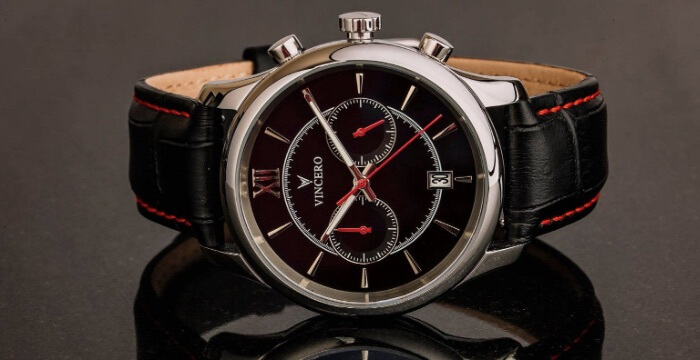


0 comments